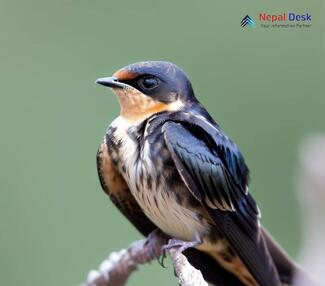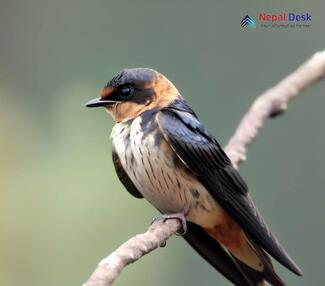The Striated Swallow (Cecropis striolata) is a fascinating bird species that can be found across various parts of Asia, including Nepal. These agile fliers, characterized by their distinct and striking appearance, captivate the attention of birdwatchers and nature enthusiasts alike. This article aims to uncover all there is to know about the Striated Swallow and its presence in Nepal.
Physical Features and Habitat
Sporting a mix of dark blue, chestnut brown, and white coloration with bold streaks on their underparts, making them easily distinguishable from other swallow species. They boast a body length of about 20-23 cm, along with deeply forked tails that showcase white spots.
The Striated Swallow can be found inhabiting open areas such as grasslands, forests, agricultural lands, and river valleys. They are widespread across several Asian countries like India, Malaysia, Sri Lanka, China, and Indonesia. The presence of these birds in Nepal is no exception – they are predominantly observed in localities situated in the southern Terai regions.
Diet and Reproduction
Striated Swallows feed primarily on insects – their diet mostly includes flies, mosquitoes, ants, termites, and other flying insects. Capturing these tiny prey items while in flight showcases the remarkable agility of these birds.
Breeding usually commences between March and July. Their nests are unique architectural marvels made from mud pellets. Constructed against cliffs or man-made structures like bridges or buildings' eaves, these nests can house up to six eggs at once.
Preserving Striated Swallow Populations in Nepal
While the Striated Swallow is not considered an endangered species globally as per the IUCN Red List assessment, habitat loss due to deforestation and human activities may pose a threat to their population. It's crucial that adequate measures are taken to conserve and protect these remarkable birds in Nepal.
To conclude, the Striated Swallow (Cecropis striolata) is a captivating bird species often adorning the skies of southern Nepal. Understanding their unique characteristics, habitat preferences, diet, reproductive behavior, and the potential threats to their population offer valuable insights into their conservation efforts. Basking in their presence adds an incredible touch of beauty for birdwatchers and nature lovers exploring the breathtaking landscape of Nepal.




